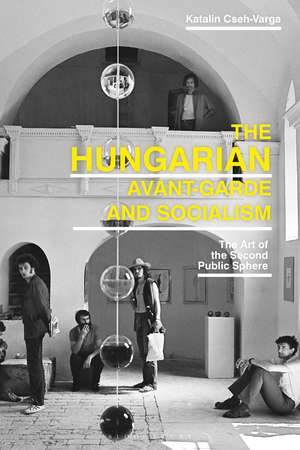The Hungarian Avant-Garde and Socialism: The Art of the Second Public Sphere
Autor Katalin Cseh-Vargaen Limba Engleză Hardback – 2 noi 2022
| Toate formatele și edițiile | Preț | Express |
|---|---|---|
| Paperback (1) | 191.92 lei 6-8 săpt. | |
| Bloomsbury Publishing – 29 mai 2024 | 191.92 lei 6-8 săpt. | |
| Hardback (1) | 543.25 lei 3-5 săpt. | |
| Bloomsbury Publishing – 2 noi 2022 | 543.25 lei 3-5 săpt. |
Preț: 543.25 lei
Preț vechi: 775.73 lei
-30% Nou
Puncte Express: 815
Preț estimativ în valută:
103.98€ • 112.99$ • 87.40£
103.98€ • 112.99$ • 87.40£
Carte disponibilă
Livrare economică 31 martie-14 aprilie
Preluare comenzi: 021 569.72.76
Specificații
ISBN-13: 9781350211582
ISBN-10: 1350211583
Pagini: 264
Ilustrații: 25 bw illus
Dimensiuni: 156 x 234 mm
Greutate: 0.7 kg
Editura: Bloomsbury Publishing
Colecția Bloomsbury Visual Arts
Locul publicării:London, United Kingdom
ISBN-10: 1350211583
Pagini: 264
Ilustrații: 25 bw illus
Dimensiuni: 156 x 234 mm
Greutate: 0.7 kg
Editura: Bloomsbury Publishing
Colecția Bloomsbury Visual Arts
Locul publicării:London, United Kingdom
Caracteristici
Uses the notion of the second public sphere as a productive theoretical and methodological framework to understand the operating mechanisms of avant-garde art in late socialism
Notă biografică
Katalin Cseh-Varga is a Hertha Firnberg Fellow at the Institute of Art Theory and Cultural Studies, Academy of Fine Arts Vienna, Austria.
Cuprins
1. Acknowledgements 2. Introduction 3. Public Spheres and Spatiality 4. The Happening and the Consolidation of the Art of the Second Public Sphere 5. Places of Resonance - Artist Studios 6. Official Venues, Semi-Official Art: Party-Run Locations 7. Turning Private into Public - Apartment Culture 8. Avant-Garde above the Ground 9. Conclusion 10. Bibliography
Recenzii
This astute monograph offers a survey of Hungarian avant-garde art of the 1960s-80s that is at once accessible and methodologically rigorous. Its elucidation of the entanglements between the first (official) public sphere and its counterpart, the second (unofficial) public sphere, is thoroughly invigorating.
'This timely and expertly researched study of unofficial Kádár-era art explores the resourcefulness and ingenuity of Hungarian artists keen to push the limits of artistic freedom. The book is indispensable for anyone interested in the question what it meant to be radical for an artist in post-1956 Hungary, and beyond.'
Drawing on a wealth of research, Cseh-Varga provides a new and accessible interpretation of radical art phenomena in Hungary under socialism. The book points to the importance of the public sphere for the democratic ambitions and battles with authority of the East European neo-avant-garde.
'This timely and expertly researched study of unofficial Kádár-era art explores the resourcefulness and ingenuity of Hungarian artists keen to push the limits of artistic freedom. The book is indispensable for anyone interested in the question what it meant to be radical for an artist in post-1956 Hungary, and beyond.'
Drawing on a wealth of research, Cseh-Varga provides a new and accessible interpretation of radical art phenomena in Hungary under socialism. The book points to the importance of the public sphere for the democratic ambitions and battles with authority of the East European neo-avant-garde.
